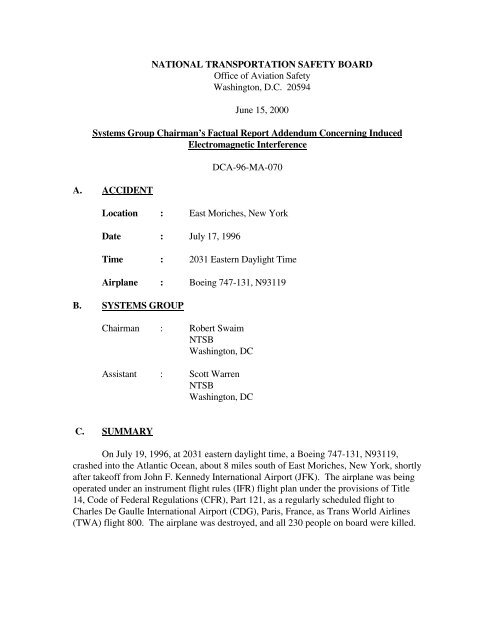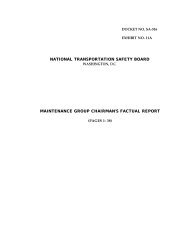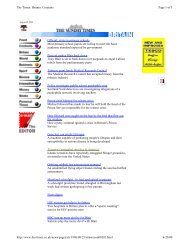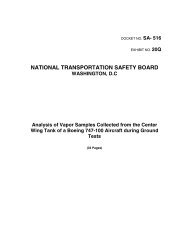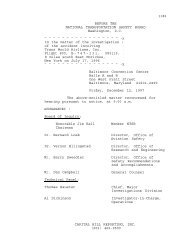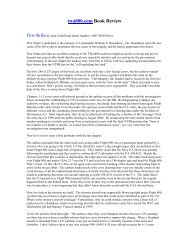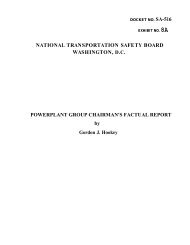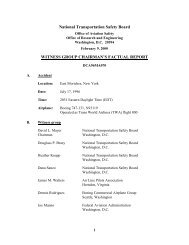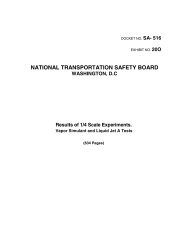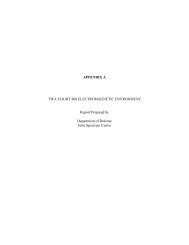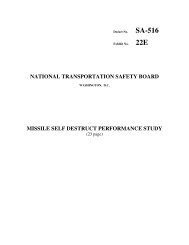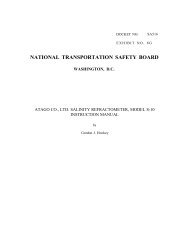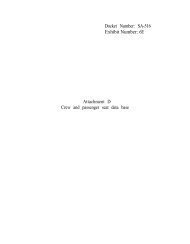Electromagnetic Interference - TWA Flight 800 Investigation
Electromagnetic Interference - TWA Flight 800 Investigation
Electromagnetic Interference - TWA Flight 800 Investigation
- No tags were found...
You also want an ePaper? Increase the reach of your titles
YUMPU automatically turns print PDFs into web optimized ePapers that Google loves.
NATIONAL TRANSPORTATION SAFETY BOARDOffice of Aviation SafetyWashington, D.C. 20594June 15, 2000Systems Group Chairman’s Factual Report Addendum Concerning Induced<strong>Electromagnetic</strong> <strong>Interference</strong>A. ACCIDENTDCA-96-MA-070Location : East Moriches, New YorkDate : July 17, 1996Time : 2031 Eastern Daylight TimeAirplane : Boeing 747-131, N93119B. SYSTEMS GROUPChairman : Robert SwaimNTSBWashington, DCAssistant : Scott WarrenNTSBWashington, DCC. SUMMARYOn July 19, 1996, at 2031 eastern daylight time, a Boeing 747-131, N93119,crashed into the Atlantic Ocean, about 8 miles south of East Moriches, New York, shortlyafter takeoff from John F. Kennedy International Airport (JFK). The airplane was beingoperated under an instrument flight rules (IFR) flight plan under the provisions of Title14, Code of Federal Regulations (CFR), Part 121, as a regularly scheduled flight toCharles De Gaulle International Airport (CDG), Paris, France, as Trans World Airlines(<strong>TWA</strong>) flight <strong>800</strong>. The airplane was destroyed, and all 230 people on board were killed.
D. DETAILS OF THE INVESTIGATIONThe National Transportation Safety Board tasked the Naval Air Warfare Center –Aircraft Division, located in Patuxent River, Maryland to conduct a program investigatingtwo areas related to electromagnetic interference (EMI) and the accident involving <strong>TWA</strong>flight <strong>800</strong>. The NAWC-AD was tasked to evaluate the following effects on the airplane:1) The effect of internally generated EMI from normal operation of aircraft systemson the fuel tank wiring;2) The effect of different electrical system configurations on the characteristics ofthe Captain’s channel of the cockpit voice recorder (CVR).Task 1 was designed to help determine if electromagnetic interference could have been athreat to the fuel tank wiring on the airplane, and task 2 was intended to help establishpotential electrical system configuration effects on the recorded signal of the CVR.The NAWC-AD prepared a report, dated June 12, 2000, which has been included asappendix A to this addendum.Scott WarrenAerospace Engineer
APPENDIX ABOEING 747-100 FUEL QUANTITY INDICATION SYSTEM (FQIS)SUSCEPTIBILITY TO INDUCED ENERGY FROM CAPACITIVE AND INDUCTIVECABLE COUPLINGReport Number: NAWCADPAX/TR-2000/33Final ReportJune 12, 2000Report Prepared byNaval Air Warfare Center – Aircraft DivisionPatuxent River, Maryland


